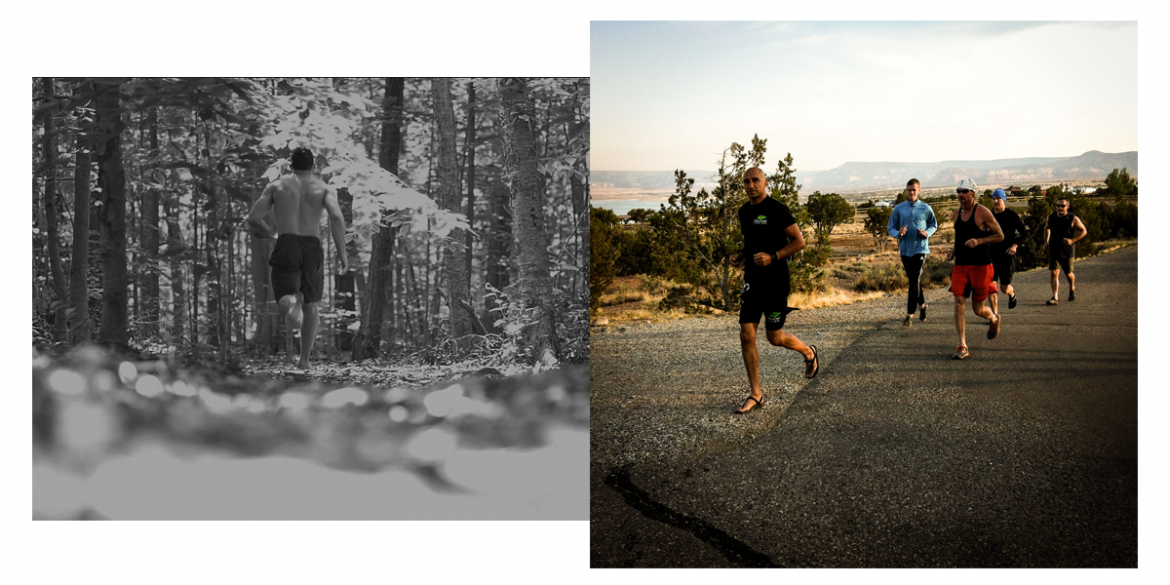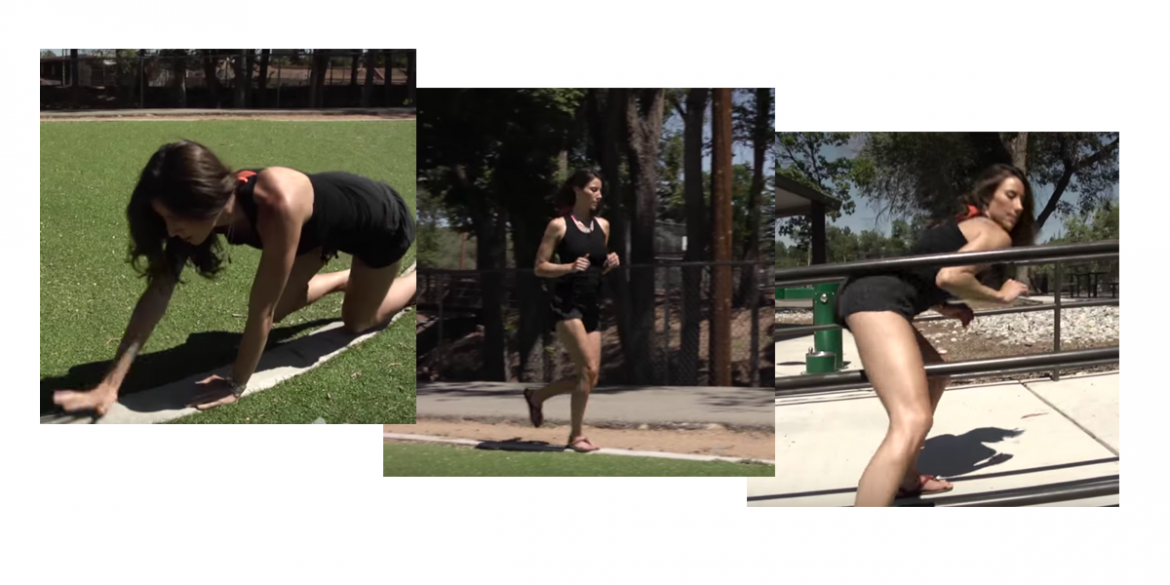
The Best and Worst Movement You Can Do
by Danny Clark, Performance Director & Master Instructor
Quick and Dirty Details:
- To a varying degree, we are all designed to be able to run efficiently
- In the absence of the ability to perform basic natural tasks, running is likely highly inefficient at best; and reinforcing the breakdown of your entire body at worst
- Video: Breathing and positioning tutorial; Ground movement for restoration
- Program: Beginner’s “ramp up” program for healthy Movnatters
- Enhance your running routine for maximum benefits
Running. I used to hate it. Correction: I used to abhor it. When I was a young athlete, I avoided it like a staph infection because anything longer than a sprint wasn’t among my natural strengths…I’m much more naturally “wired” for explosive movements. And as I reached my late twenties, I outright couldn’t even run a casual mile without pain in one or more joints.
My disdain for running was further reinforced as I transitioned from athlete to fitness professional – and was introduced to an industry where there’s a pervasive stigma that running destroys joint integrity and overall movement quality. Articles in many fitness circles run rampant with all kinds of pavement pounding, posture deteriorating anti-running propaganda designed to mitigate our clients love of running (or scare them from starting) and shift it over to our collective resistance training fetish. Or there’s the segment of die-hard runners, insisting all you need to do is run.
What I’m going to do today is change your perspective about running. Actually, I have an even loftier goal: I’m going to change your perspective about movement in general. Because once I changed mine, “magical” new doors opened for myself and my students. And let me just say this: I’m not going to teach you how to run in this article nor am I going to dissect the subtle biomechanics of running economy. Personally, I think that route is the most ineffective way to restore your ability (and desire) to actually run well.
Natural Movement isn’t “Optional”
To set the stage, let me reiterate a point I’ve made many times now: the root biological purpose of all movement is to be able to complete practical tasks in complex environments (read more about that here). Therefore, it’s logical to deduce that gait patterns-chiefly crawling, walking, and running-have a very real and meaningful purpose for human beings from an evolutionary perspective. Since our bodies were literally (not figuratively) selected to complete these fundamental tasks, it’s fairly safe to make the bold, counter-culture statement that all of these gait patterns are essential for our health and well-being.

The inverse statement is even more potent: In the absence of our ability to practice a variety of basic gait patterns such as crawling, walking, and running, our wellness and overall health will suffer.
Here’s where things get interesting. As “fundamental” as running is, it’s a very complex and difficult movement to perform well under modern conditions. I’m going to venture to say that running is actually an “apex” movement, hence its position as a Level 2 movement in the MovNat curriculum. Further, I’d say our ability to run both effectively and efficiently at varying speeds and distances is actually one proxy for our overall ability to move naturally and “well.”
Ready to starting running again? Start here.
While hopefully you’ve already found some inspiration to start running by now, I don’t want you to sprint to the nearest natural running coach. Because your body isn’t ready yet. Here’s how I know:
- You don’t have the ability to sit fully upright on the ground for more than a minute (or at all).
- You don’t have the balance of tension and relaxation to roll sideways efficiently.
- You can’t walk on your knees very far without feeling it in your lower back
- You can’t comfortably hold a deep squat position
- Your neutral standing position (aka “posture”) lacks integrity and therefore your visual field is sub-optimal
- You can’t jump 12 inches in the air and not come crashing down on your heels
While you may be able to perform a few of these tasks, few can perform all of them well despite their simplicity. I know I couldn’t, despite world-level athletic accomplishments, before I started MovNatting. And these are just a small selection of a huge list of fundamental, natural, practical tasks one should be able to complete effortlessly before running often. Your kids probably can perform most; why can’t you with your decades of more movement experience?
I know, I know you want the rationale, the science behind this logic. At the physiological level, amazing things happen under your skin when you start stimulating your body and moving better in a wide range of natural movements/positions. Literally right underneath your skin we’re all equipped with this amazing network of connective tissue (fascia), which is designed to help you transmit force more effectively and efficiently. When enable your body to make running less muscular and more elastic (fascial), suddenly we get that anecdotal evidence that confirms we really are “Born to Run” and “Born to Walk” [1]. In a nutshell, instead of asking our body to get more efficient at tasks such as sitting in a chair and whatever limited scope of things we do (or don’t do) in our exercise program, we need to ask it to develop efficiency in a (much) wider spectrum of natural movement. By doing so, we work with our biological design instead of against it.
As one of my strength mentors Pavel Tsatsouline once quipped: trying to manage high loads/forces [Pavel is partial to lifting heavy things] on a poor foundation is like trying to fire a cannon off a shoddy rowboat. Moving with abandon toward the foundational abilities of your body never bodes well for that elusive, yet sought after outcome of sustainable health.
And to further digress for a moment, the tale is the same with all “apex”, higher level natural movements that so many people think is beyond their capability. The empowering truth is that you don’t need to be as durable as a teenager or as knowledgeable as an anatomist to move well; in fact you don’t even need to know the name of a single muscle in your body (notice I didn’t need to identify muscles in the list above). You just need to be familiar with the basic “head, shoulders, knees, and toes” and change your perception of how to approach restoring your ability to move naturally.Anyways. Back to the point.
Here’s a step-by-step blueprint to get you moving today toward efficient running:
- Start by learning and practicing efficient breathing in an optimal lying position (which helps reinforce optimal upright positioning). Here’s a starter video:
https://youtu.be/bnBWdYktyrM - Practice natural ground movement sequences every day. Here’s a sped up version of one of my daily 5-10 minute sequences:
https://youtu.be/uXHb5TsY7W4 - Continue to build “From the Ground Up” – crawl well before you walk. Walk well before you run. And learn how to manage ground reaction forces by working on basic jumping technique. Direct coaching via a MovNat workshop or certification is the best path to take. Online coaching coming very soon.
- Practice running by working on the elements of the specific technique (focus on feeling it, not just intellectualizing it) carrying over the cumulative lessons you’ve learned from practicing a wide spectrum of natural movement.
-
Here’s a one month, twice a week “ramp up” program for beginners:
Week/Day Duration Distance Intensity 1/1 10 minutes not calculated low 1/2 not calculated 1 mile medium 2/1 15 minutes not calculated low 2/2 not calculated 1.5 miles medium 3/1 20 minutes not calculated low 3/2 not calculated 2 miles medium 4/1 25 minutes not calculated low 4/2 stopwatch timed 1.5-2 miles high All the runs based on “duration” are performed totally relaxed, with attention on technique and without attention on maintaining a specific pace. All the runs based on “distance” are performed at a slightly more intense pace. Pre-calculate your route using a trail map. Week 4, Day 2 is a timed “benchmark” run, which will be a run you perform every 4-8 weeks to gauge your progress. I don’t like to benchmark long runs, as I prefer simply continue to increase duration and eventually monitor pace instead of time. This is a simple, but very effective way to practice linear progression. Don’t get hung up on the details, but do understand the logic.
- Don’t stop there. Continue to run at varying distances and speeds.
- And don’t stop there. Run in complex environments to further refine your ability to run. Do more than “trail run”…break up your run with other natural movements over natural obstacles. MovNat team leader Stefano Tripney calls this an “enhanced run.”

- And finally, don’t specialize: continue to practice a wide variety of natural movements as often as possible.

So, with this perspective it’s easy to see why running can be both the best and worst possible thing for your body. For, me its been both-and the journey toward healthy running has been well worth the journey! The path to making it’s practice good for you is right in front of you. It isn’t easy, and it’s not necessarily free (we all benefit from coaches; I pay coaches for anything I want to accomplish efficiently). All you need to do is take those first steps.

Suggested readings:
MacDougall, Chris “Born to Run”
Earls, James “Born to Walk”
Bowman, Katy “Move Your DNA”

